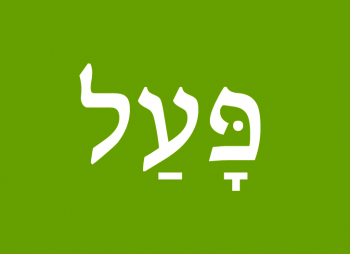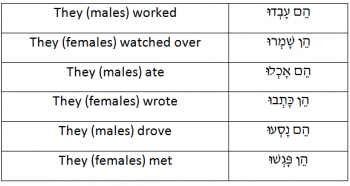Hebrew Verbs in Action: Binyan pa’al Posted by Ayana on Feb 18, 2019 in Uncategorized
Hebrew verbs are composed of roots and verbal stems. The basis of every verb is the root, which is comprised of three letters. The verbal stems – the בּׅנְיָנׅים (bin-ya-nim) – are the patterns that shape the roots into actual words. בִּנְיָן (bin-yan) is a firm structure of prefix, suffix and punctuation, into which the root is inserted to form the verb.

The Hebrew language has seven binyanim:
Pa’al פָּעַל
Hiph’il הִפְעִיל
Pi’el פִּעֵל
Pu’al פֻּעַל
Niph’al נִפְעַל
Huph’al הֻפְעַל
Hitpa’el הִתְפַּעֵל
The name of each binyan indicates the sound of its masculine singular form in the past tense. All the masculine singular verbs of binyan pa’al in past tense consists of two syllables of the vowel ‛a’. The first syllable is open, the second is closed. The root נ-ת-נ (n-t-n), for example, is defined as to give. Conjugated as masculine singular in the past tense of binyan pa’al, the root needs no prefix or suffix. It appears as נָתַן, pronounced as na-tan, and means (he) gave. The verbs in the following sentences are all pronounced with the two syllables of ‛a’:
הוּא עָבַד אֶתְמוֹל שְׁמוֹנֶה שָׁעוֺת.
He worked eight hours yesterday.
אַחַר הַצָּהֳרַיִם הוּא שָׁמַר עַל אַחְיָנִית שֶׁלוֺ.
In the afternoon, he watched over his niece.
בָּעֶרֶב אָכַל עׅם חֲבֵרִים בְּמִסְעָדָה.
He ate dinner at a restaurant with friends.
Hebrew verbs conjugate according to the gender of whomever is performing the action. When the pronoun is feminine the verb will be conjugated as feminine as well. In past tense, the letter ה will be added as a suffix to the verb, making it a three syllable word. The first syllable vowel is still ‛a’, the second becomes ‛e’, and the third ‛a’. The root נ-ת-נ (n-t-n), conjugated as feminine singular in the past tense becomes נָתְנָה (na-te-na). For example:
שָׁנָה שֶׁעָבְרָה הׅיא כָּתְבָה אֶת סֵפֶר הַבִּכּוּרִים שֶׁלָהּ.
Last year she wrote her first book.
בַּחוֺרֶף הׅיא נָסְעָה לְחוּפְשָׁה.
In the winter she went on vacation.
בְּמַהֲלָךְ הַחוּפְשָׁה הׅיא פָּגְשָׁה אֶת אֲחׅיָהּ.
She met her brother during her vacation.
The first pronoun, whether it’s masculine or feminine, receives the suffix תׅי (ti) in the past tense. The first two syllables keep the ‛a’ sound. For example:
עָבַדְתּׅי שָׁנָה שְׁלֵמָה כְּדֵי לַחְסוֺךְ כֶּסֶף לַלּׅימוּדׅים.
I worked a whole year to save money for school.
אַחֲרֵי הַלּׅימוּדׅים נָסַעְתּׅי סוֺף סוֺף לְחוּפְשָׁה.
After graduation, I finally went on vacation.
This also applies to the pronoun אֲנַחְנוּ (we). The first two syllables are pronounced with the ‛a’ vowel. The added suffix – נוּ (nu) for this pronoun – forms the third syllable. For example:
אָכַלְנוּ יַחַד אֲרוּחַת צָהֳרַיִם.
We ate lunch together.
פָּגַשְׁנוּ אֶת אָחוֺתְךָ אֶתְמוֹל.
We met your sister yesterday.
Hebrew has two different pronouns for ‛they’. One for females – הֵן. Another for males or a mixed group of males and females – הֵם. Both of them function the same in the past tense of binyan pa’al. The first syllable maintains its ‛a’ sound. The second vowel changes to ‛u’ sound.

To summer the past tense of binyan pa’al I used the verb לׅכְתּוֺב (to write):

The conjugations in the present tense of binyan pa’al for every pronoun are more similar to each other. The first syllable receives the sound ‛o’ in every conjugation, the second becomes ‛e’. Some of the pronouns receive a suffix as shown with the verb לׅכְתוֺב in the following chart:

The singular masculine pronouns ‛he’ and ‛you’ are similar to the first male pronoun verb. The first female pronoun ends with םֶםֶת. So are the singular feminine pronouns ‛she’ and ‛you’ when addressing a female. The plural feminine pronouns ‛they’ and ‛we’ end with םוֺת. The plural masculine pronouns ‛they’ and ‛we’ end with םׅים.
In the future tense, the main addition is the אית”ן letters. These four prefixed letters indicate future tense in any binyan. The letter א is attached to the first pronoun only, the letter י is attached to the third pronouns ‛he’ and ‛they’, the letter ת is attached to the third pronoun ‛she’ and the second pronoun ‛you’, the letter נ is attached only to the plural first pronoun.

For more practice watch this video:
https://www.youtube.com/watch?v=6RJBpvu8lyA
Related post:
Hebrew Verbs in Action: Binyan Pi’el
Keep Calm and Learn Hebrew!

Build vocabulary, practice pronunciation, and more with Transparent Language Online. Available anytime, anywhere, on any device.



